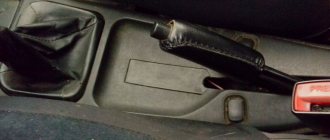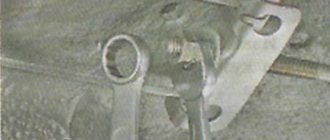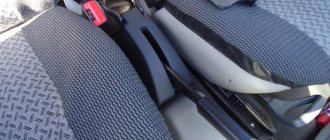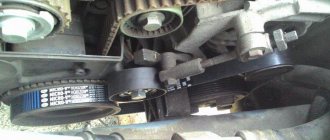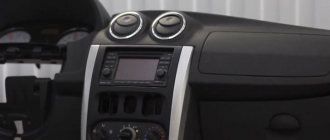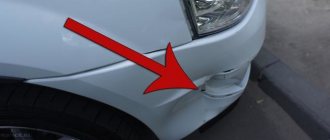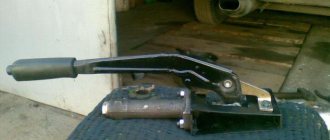- Why is the brake light on?
- Possible reasons why the handbrake light is on: opinions of car owners
- How is the replacement performed?
- When to tighten and when to change?
- When to tighten the nut
- Components
- The principle of adjusting the handbrake
- Causes of malfunction and their elimination
- Checking the mechanical component
- Recommendations for the braking system
- Handbrake repair for Lada Vesta
Why is the brake light on?
But let's start with the design features of the brake system alarm. Previously, cars used only one sensor - the level of brake fluid in the system, which sent a signal to the warning lamp. Since fluid is the main working element of the system, and its leakage leads to the brakes stopping working, naturally, the designers installed a sensor to monitor the level.
Additionally, the car also has a parking brake, the use of which must be monitored by the driver. On some models, the warning lamps for the working and parking systems are separated. The warning light with an exclamation mark in a circle is responsible for the fluid level, and the indicator marked with the letter “P” signals that the handbrake is engaged, and it turns off after the car is released from the handbrake.
But often a car has only one warning light, to which both the liquid level sensor and the handbrake sensor are “attached”.
Modern cars use circuits that additionally include brake pad wear sensors and brake light lamps. Failure of these elements causes the lamp on the dashboard to light up.
There are other design nuances that cause the indicator to glow. On VAZ models of the 10th family of the first years of production, a starter protection relay was included in the circuit, which forcibly turned it off after starting the engine. In this circuit, the designers connected the power supply circuit for the brake system lamp to this relay.
Why does the brake warning light on the dashboard come on or does not go out after starting the engine? If this happens while moving, it is better to stop moving and carry out diagnostics. If the light does not go out after starting the engine, it is better not to drive until the problem is resolved.
Wiring diagram LADA Largus
All units, including the K4M and K7M engine control circuit, battery charging circuit, low beam headlights and fog lights, turn signals and hazard warning lights, fuel pump and fuel level sensor, horn and sound system speaker connections, windshield cleaners and washers glass and rear door glass, electric front and rear door lifts, central door locking system and interior heating and ventilation system, other modules.
Possible reasons why the handbrake light is on: opinions of car owners
- Changed the hubs. “The light in my car blinked sometimes. At first I decided that the problem was with the pads. But later I remembered - I replaced the pads not so long ago. I checked the brake, everything is fine. And then I thought about why the problem could arise? I didn’t think of anything and stopped worrying. The indicator continued to flash periodically... As a result, the right hub bearing began to make noise, after a while it began to hum so loudly that the sound simply made my head split. I first purchased one hub. Then I thought that it would be better to change both parts at once - or rather, this should be done. I bought a second one, changed it, and the problems all disappeared: no noise, no blinking light.”
- Got a good technician! “The handbrake light would come on from time to time while driving. Quite often this happened after bouncing on the pit. I went and bought a brake fluid. And I found a specialist right at the dealership. He then flooded it. He also climbed under the handbrake and said that perhaps the microphone at the lever was acting up (it seems like this happens sometimes). Take the train and watch. But the problem disappeared after filling the brake fluid. The handbrake no longer lights up. By the way, I met an excellent specialist and looked for the problem for free, with pleasure and without showing off.”
- Depending on the situation, “If the light starts to light up after shocks, for example, on a hole or bump, then, most likely, the brake fluid level is on the verge of the required level or lower. You just need to add it and that's it. If it lights up when braking, the pads are definitely worn out completely. I went through this myself in my VAZ.
How is the replacement performed?
When replacing Renault Logan parking brake cables, our video will show you what to do when doing the repair yourself. It is worth noting that the right and left rear cables are changed in the same way.
To restore the handbrake of Renault Sandero, LADA Largus, the installed cable is removed and replaced as follows:
- The tension of the drive cables is loosened by unscrewing the adjusting drive nut on the handbrake.
- The brake drum is removed.
- The rear brake pad is removed, and the cable tip is disconnected from the lever, which removes the pad itself.
- The cable sheath clamp is compressed.
- The cable is removed from the hole.
- The cable is removed from the holder located on the beam lever.
- It is necessary to pull it a little into the cabin, and then remove it from the equalizer.
- We completely remove it from the hole in the body.
When replacing the handbrake cable on a Logan, you may encounter a situation where it cannot move freely in the sheath. Therefore, it must be lubricated with transmission or engine oil (at your own discretion).
Even before replacing the handbrake cable, it is important to make sure that the new cable is long enough to be installed on the vehicle. Otherwise you will have to buy a new consumable.
As is clear from the instructions, the procedure is quite simple. The parking brake will be repaired only if all operations for independently replacing the cable and checking its operation by placing the car on an incline on the handbrake are followed. The new part is guaranteed to last for several years without any problems.
Parking brake device
Before replacing the handbrake cable or tightening it, you need to understand the design of the mechanism. It is designed quite simply and consists of the following main parts:
- Lever with spring-loaded button and latch. Located in the cabin on the right hand of the driver.
- A metal rod with a pin at the end and a rocker arm for installing the cable is located under the bottom of the car and attached to the lever. This is the “handbrake” tensioning device.
- The ends of the cable (or two cables), installed on the rocker arm, are attached to the brake levers of the rear wheels - disc or drum.
When to tighten and when to change?
During operation of the machine, the steel cable gradually stretches and begins to sag. Then part of the lever stroke is used to remove this slack (the first 2-3 clicks), and only then the force is transferred to the brake pads of the rear wheels. As a result, they are weakly pressed against the surface of the discs or drums and the car does not brake reliably.
The first sign of a malfunction is that the handbrake stops working on the first two clicks of the handle and is raised by hand without any effort. In this case, it is definitely necessary to tighten the hand brake, or rather the cable drive.
But the operation of the mechanism also depends on other factors:
- on the degree of wear of the brake pads;
- from the depth of excavation on the surface of the steel disk or drum.
Abrasion of the linings does not have much effect on the operation of the main system, since the stroke of the hydraulic pistons is quite large. But the effect of the mechanical “handbrake” gradually weakens. To return it to working condition, it is necessary to compensate for the wear of the elements by tensioning the drive.
The cable is replaced in the following situations:
- The element has stretched to such an extent that at maximum tension the pads do not grip the discs and the car rolls away on any slope.
- Due to the constant ingress of water under the cable casing, it rusted and became tightly jammed. This happens when a motorist rarely uses the handbrake.
Cable jamming also occurs in winter, when water trapped under the casing freezes inside. In this situation, do not rush to change it; first warm up the car in the garage, and then drive out the moisture using WD-40 aerosol lubricant.
Instructions for tensioning and replacing the drive
Since the parking brake system mechanism is located under the bottom of the car, an inspection ditch, overpass or lift is needed to perform the work. In extreme cases, you can do without them, but then you will have to hang out the back of the car and lie under it, which is not only inconvenient, but also dangerous. Before tightening the cable, securely secure the front wheels of the vehicle with wheel chocks.
Then act in the following sequence:
Replacing the cable drive will require more time, especially to disassemble the drum brake system. To hang both rear wheels, prepare wooden blocks, and to replace them, use a standard set of tools; no special devices are required. The algorithm of actions is as follows:
Install the new cable drive in the reverse order, starting with the wheel mechanisms. At the end, tighten it and check the operation of the handbrake.
A loose handbrake cable usually occurs due to two reasons:
If you compare the Largus handbrake adjustment design with other domestic cars, you can feel a strong difference. Yes, this is understandable, because in Largus from a Russian manufacturer there is only one assembly and a name. Now let's get down to business.
When to tighten the nut
If this does not help you, you will have to use the adjusting nut to adjust the brakes. To do this you need to do the following.
- Open the plastic plug under the handle. It can be easily removed.
- Remove another plug, under which there is an adjusting nut.
- Take a long 10mm socket and tighten the nut.
This completes the adjustment of the hand brake on the Lada Vesta. But I didn’t do this on my car (or rather, not mine, but my wife’s), because I think that automatic adjustment was enough. Therefore, I also advise you to use the automatic function first. If this is not enough, then tighten the nut.
On the Lada Vesta, to adjust the handbrake you no longer need to crawl under the car, as before on the “nines” and “fours”. I hope that the review was useful for someone, and someone probably already knew this trick. Thank you for reading, good luck on the roads everyone!
Adjusting the hand brake on Lada Largus
The first step is to unscrew the bolt securing the plastic casing under the handbrake lever, which is clearly shown in the photo below:
Then remove this cover completely so that it does not interfere.
Then, under the lever itself, we bend the so-called cover to the side, and there we see a nut on the rod. You need to tighten it clockwise if you want to tighten the handbrake. After several revolutions, it is advisable to check the operation of the handbrake so that it is not overtightened.
It is most convenient to tighten using not a regular open-end wrench, but a socket wrench or a deep socket with a crank.
When the adjustment is completed, you can put all the removed interior parts back in place.
Typically, adjustment is required very rarely and it is possible that during the first 50,000 km you will never even do this once, since it will not be necessary.
If the car does not stay in one place when using the handbrake, it is necessary to service its mechanism. In particular, you should replace the handbrake cables on Renault Logan, Renault Sandero, Lada Largus, where the video on our page will fully reveal the main points of replacing the cable.
Components
In such a situation, there are 2 scenarios:
- Carry out modifications in accordance with the factory diagram;
- Purchase components from another manufacturer.
And so, one of the owners of the Lada Vesta in the Exclusive configuration said that he was able to find out from an AvtoVAZ employee exactly what components were needed to replace drum brakes with disc brakes.
According to an employee of the plant, there is no need to replace the beam or reflash the ABS block, and this significantly speeds up and reduces the cost of the work.
In addition, the picture clearly shows that there is a standard spacer between the axle and the beam and it is to this spacer that the boot is fixed. From the factory, the hub and disc come separately, so after installing the rear disc brakes on the Lada Vesta yourself, there is no need to replace the bearings if you need to replace the disc.
All the components necessary to replace the brakes with your own hands are presented in the table along with the article numbers.
| Position | vendor code |
| Right brake hose mounting bracket | 8450031136 |
| Left brake hose mounting bracket | 8450031137 |
| Rear brake flexible hose assembly – 2 pcs. | 8450031129 |
| Rear brake pads (full set) | 11196-3502089-00 |
| Washer 10 | 00001-000516870 |
| Ball joint fixing bolt | 21080-2904194-00 |
| Washer 10 | 00001-000516870 |
| Ball joint fixing bolt | 21080-2904194-00 |
| Rear left brake (assembly) | 8450031163 |
| Rear right brake (assembly) | 8450031162 |
| Retainer fixing screw | 21080610526810 |
| Rear brake disc | 8450031131 |
| Rear wheel hub (assembly) | 8450031130 |
| Hex Head Screw | 00001-003836021 |
| Right rear brake guard | 8450031686 |
| Left rear brake guard | 8450031687 |
| Bolt M10-1.25-40 | 8450031161 |
| Left rear brake mount | 8450031132 |
| Right rear brake mount | 8450031133 |
The estimated cost of the entire kit for self-installation of rear disc brakes on a Lada Vesta is about 30,000 rubles.
Car fuses and relays
Fuse and relay box in the passenger compartment
The fuse box in the passenger compartment is located on the left side of the instrument panel, under a plastic cover. Remove the cover using the notch on the bottom.
| № | Current, A | Color | Protected target |
| F1 | 20 | Yellow | Windshield wiper, windshield wiper switch, heated tailgate relay |
| F2 | 5 | Beige | Instrument cluster, fuel pump relay, engine control unit (ECU) |
| F3 | 10 | Red | Brake light switch |
| F4 | 10 | Red | Diagnostic connector, immobilizer antenna unit, body electrical control unit |
| F5 | — | — | Reserve |
| F6 | — | — | Reserve |
| F7 | — | — | Reserve |
| F8 | — | — | Reserve |
| F9 | 10 | Red | Instrument cluster, left low beam |
| F10 | 10 | Red | Low beam right headlight |
| F11 | 10 | Red | Instrument cluster, left high beam |
| F12 | 10 | Red | High beam right headlight |
| F13 | 30 | Green | Rear door window motors |
| F14 | 30 | Green | Front door power window motors |
| F15 | 10 | Red | ABS electronic control unit, acceleration sensors, steering angle sensor |
| F16 | 15 | Blue | Electrically heated front seats |
| F17 | 15 | Blue | Sound signal Lada Largus |
| F18 | 10 | Red | Left front and rear parking lights |
| F19 F20 | 10 7,5 | Red Brown | Right front and rear parking lights, glove compartment lighting, instrument cluster lighting, hazard warning switch, HVAC control unit, audio system, cigarette lighter, central locking switch, front door power window switches, license plate lights, right lights front and rear position lights Rear fog light |
| F21 | 5 | Beige | Electrically heated exterior mirrors |
| F22 | — | Reserve | |
| F23 | — | — | Reserve |
| F24 | Reserve | ||
| F25 | — | Reserve | |
| F26 | 5 | Beige | SRS system |
| F27 | 20 | Yellow | Tailgate wiper motor, horn, TDC sensor, reverse light switch |
| F28 | 15 | Blue | Interior electrical control unit (energy saving mode) |
| F29 | 15 | Blue | Interior electrical control unit, diagnostic connector |
| F30 | 20 | Yellow | Interior electrical control unit |
| F31 | 15 | Blue | Fog lights, fog light relay |
| F32 | 30 | Green | Heated tailgate glass |
| F33 | — | Reserve | |
| F34 | — | Reserve | |
| F35 | — | Reserve | |
| F36 | 30 | Green | Electric motor for heating, air conditioning and ventilation systems |
| F37 | 5 | Beige | Electric exterior mirrors |
| F38 | 15 | Blue | Audio system, cigarette lighter |
| F39 | 10 | Red | HVAC Motor Relay |
Fuse and relay box in the engine compartment
Other relays and fuses for the engine management system are installed in the mounting block, which is located in the engine compartment to the left of the battery. To open the box, press the latches on the side, back and front of the lid.
| № | A | Name |
| 43 | 25 | Gas control system (LPG) |
| 44 | 25 | Anti-lock braking system (ABS) control unit |
| 45 | 50 | Anti-lock braking system (ABS) control unit |
| 46 | 60 | Ignition switch, on-board network protection (fuses (F28-F32, F36) located in the passenger compartment), light switch circuits |
| 47 | 60 | On-board power supply protection, passenger compartment fuse box (fuses located after the ignition switch), light switch circuits |
| 51 | 25 | Fuel pump, engine control system controller, engine cooling fan relay, engine control unit relay, air conditioning compressor clutch relay, ignition coils 1-4 cylinders (VAZ 21129), ignition coil 2×2 (VAZ 11189), oxygen sensors, purge valve adsorber, intake pipe length control valve (VAZ 21129), injectors, phase sensor (VAZ 21129) |
| 52 | 40 | Engine cooling fan, air conditioning compressor clutch |
| Relay | ||
| R1 | Gas control system (LPG) | |
| R2 | Heater Lada Largus | |
| R3 | Front fog lights | |
| R4 | Fuel pump | |
| R5 | The engine control unit | |
| R6 | Engine Cooling Fan (High Speed) | |
| R7 | A/C compressor clutch | |
| R8 | Engine cooling fan (low speed) | |
| Relay panel number/prev. | Relay number/prev. | Relay/fuse assignment |
| 299-1 | 231(A). | Fog light relay |
| 753(B) | Headlight washer pump relay | |
| 299-2 | 233 | Heater Fan Relay |
| 597-1 | F1 (60 A), F2 (60 A) | Electronic control unit for ABS and ESP systems |
| 597-3 | F1 (50 A). F2 (25 A) | Exterior light switch, interior fuse box |
| 784 | 700(A), | Cooling fan relay |
| 474(B) | Air conditioning compressor relay | |
| 1047 | F1 (30 A), | Power supply for Lada Largus relay unit |
| F2 (25 A) | Injection relay power supply | |
| F3 (5 A), | Power supply for injection system relay, ECU | |
| F4 (15 A) | Not used | |
| 238(A). | Injection blocking relay | |
| 236(B) | Fuel pump relay |
Please note that the relay and fuse diagram may differ depending on the configuration and production date of the car. Current diagrams of the mounting block are presented in the instruction manual depending on the release date of the Lada Largus.
The principle of adjusting the handbrake
- Fully lower the handbrake lever in the cabin.
Lower the handbrake handle
- Place the car on a pit or lift it on a lift. Some car owners manage to adjust the handbrake “from the curb” - but this is inconvenient and dangerous.
- Find the resonator from the bottom of the car and remove it from the rubber brackets.
Remove the muffler from its mounting to the bodyUsing a ratchet, unscrew the 4 bolts securing the protection of the handbrake adjustment mechanism (protective screen).
Remove and set aside the protective screen
Next, you can either remove the protective screen, but it seems to me that it is easier to move it forward behind the muffler, which will free up space that is enough for free work.
The mechanism looks like this
Loosen the first nut with a 13mm wrench.
- By tightening the adjusting nut, tighten the handbrake cable that comes out of the passenger compartment.
- Ask a partner to check the stroke of the lever handle, or check it yourself.
- As soon as the handbrake moves 3-4 clicks, tighten the lock nut.
- Before the final stage of work, it is necessary to check the functionality of the brake mechanism. To do this, hang the rear wheels and watch how they rotate with the hand brake off. They also check how the wheels grip when the handbrake is raised.
The principle of operation of the handbrake on Grant
Why does it need to be tightened frequently?
This is the peculiarity of the mechanism, which is why you often have to tighten the handbrake. Plus low-quality spare parts from the beginning, and a design that has not changed since the time of Tsar Pea!
In foreign cars (not all of course), the rear brake mechanism (drum or disc) has self-tensioning springs, which are tightened depending on the wear of the pads.
How a properly configured handbrake should work
The handbrake movement in a Lada Granta car should be no more than 6 clicks from the moment it is raised. It is possible to increase the handbrake stroke to 8 clicks, but it is not recommended.
It shouldn’t be like this (the brakes don’t grab the rear wheels)
Ideally, of course, 3-4 clicks. With this setting of the handbrake, you will have a reserve of movement when the cable weakens and the wheels begin to grip later.
If you experience a situation where the handbrake is “pulled out” to its fullest extent, but the wheels do not grab, then the following reasons are possible:
- rear brake pads are worn out;
- the handbrake cable is broken or stretched/
Causes of malfunction and their elimination
As a rule, the reasons why the handbrake does not work are quite simple and do not require long or expensive repairs:
Checking the mechanical component
Self-diagnosis is a simple operation. It is divided into two components - mechanical and electrical. The first is very important, since it evaluates the condition of the brake system drive and determines its performance.
Checking the mechanical component is reduced to assessing the level of brake fluid in the reservoir and the condition of the drive lines and system components - the master brake cylinder and operating mechanisms.
The brake reservoir is located in the engine compartment, on the right near the rear panel of the engine compartment. It is not difficult to find it, since there are two wires going to the tank cap.
When checking, disconnect the wires and unscrew the cap to determine the brake fluid level. There are marks on the walls of the tank, by which you can understand how much liquid is left. A level above the middle between the marks is considered normal.
For an additional check, we start the car and press the brake pedal a couple of times, after which we roll the car back and inspect the surface of the ground for traces of leaking fluid, and check the fluid level. If it is detected, the brake line is damaged, and the amount of fluid will decrease.
If there is a brake fluid leak, the car cannot be used because the car does not have brakes. The best option in this case is to call a tow truck to deliver the car to the repair site. But if you have enough driving experience, then we get to the service station or garage on our own. Car brake systems usually have two circuits, and if the line of one of them is broken, the second continues to work.
Sometimes there is a problem with the warning light coming on when you press the brake pedal. The reason for this lies in two factors - low fluid level in the reservoir and worn disc brake pads. When braking, fluid flows into the working cylinders and the amount in the tank drops below a critical level, which is why the lamp lights up. This can be treated by installing new pads and adding fluid to the reservoir.
Instructions for replacing the rear pads of a Lada car
In order to remove the pads, you need to fix the car on a two-post electro-hydraulic lift (which not everyone has, and in this case you need to find a service station). Raise the hand drive lever and turn off the engine. Next, remove both wheels. After this, release the handbrake. Now you can adjust the height of the car for convenience.
We begin disassembling the mechanism by removing the upper and lower springs that tighten the brake. Next, remove the springs on the spacer bar (using a screwdriver or pliers) and on the guides. After this, the assembled strip itself with the mechanism is detached, which regulates the gap. Finally, having removed the handbrake cable from the lever on the block, we disconnect the rear blocks of the Lada.
To install the pads, it is necessary to assemble the gap adjustment mechanism with the pads and the parking brake cable. Then we attach this structure to the brake drum of the Lada Largus. The final stage is to install the tension springs (lower and upper) and guide springs in place. Finally, we put on the drum and wheel, after which you should check the gap adjustment mechanism by pressing the pedal all the way 3 times. If a click appears, the mechanism is adjusted.
Recommendations for the braking system
- We recommend that you replace the brake fluid at least once every 1.5-2 years. During operation, brake fluid inevitably absorbs moisture, and its boiling point decreases. During intense braking, it can boil in the working cylinders, and an air plug appears in them, which will not allow creating the required pressure, and the efficiency of the braking system will sharply deteriorate. Check the brake fluid level periodically. If it begins to decrease quickly, it means there is a leak - contact service immediately. If the level decreases, but slowly (smoothly over a run of about 10-20 thousand kilometers) and reaches a minimum, check the condition of the brake pads.
It is advisable to change brake pads/discs if the wear percentage reaches 70% or more, because it is impossible to monitor their condition frequently, and besides, the inner pad wears out more. Maintaining the brake system in good condition is the key to the safety of you and your loved ones on the road.
Use only original and high-quality spare parts in the car’s brake system. Brake pads of questionable quality may not withstand the heat during emergency braking and will not stop the car. They may have a shorter service life, squeak when braking, or wear out the brake rotors quickly.
Wire harness connection diagrams
The following shows in more detail various fragments of the electrical circuits of this car.
1.6 (8V) engine wiring harness connection diagram
1 – generator Lada Largus; 2 – air conditioning compressor; 3 – cooling system fan; 4 – additional resistor; 5 – starter R90; 6 – battery; 7 – absolute air pressure sensor; 8 – vehicle speed sensor; 9 – crankshaft position sensor; 10 – intake air temperature sensor; 11 – adsorber purge valve; 12 – control oxygen concentration sensor; 13 – connection block with the wiring harness of the control oxygen concentration sensor; 14 – diagnostic oxygen concentration sensor; 15 – connection block with the wiring harness of the diagnostic oxygen concentration sensor; 16 – ignition coil; 17 – spark plugs; 18 – nozzles;
19 – throttle position sensor; 20 – idle speed regulator; 21 – coolant temperature sensor; 22 – knock sensor; 23 – refrigerant pressure sensor; 24 – pressure sensor in the power steering system; 25 – low oil pressure indicator sensor; 26 – reverse light switch; 27 – electronic engine control unit; 28 – fuse and relay block in the engine compartment; 29 – high speed cooling fan relay; 30 – low speed cooling fan relay; 31 – air conditioning compressor relay; 32 – fuel pump and ignition coil relay; 33 – main relay Lada Largus; 34, 35 – fuses in the relay and fuse box in the engine compartment; 37 – connection block with the front body wiring harness.
1.6 (16V) engine wiring harness connection diagram
1 – generator; 2 – air conditioning compressor; 3 – cooling system fan; 4 – additional resistor; 5 – starter; 6 – battery; 7 – absolute air pressure sensor; 8 – vehicle speed sensor; 9 – coolant temperature sensor; 10 – crankshaft position sensor; 11 – intake air temperature sensor; 12 – adsorber purge valve; 13 – control oxygen concentration sensor; 14 – connection block with the wiring harness of the control oxygen concentration sensor; 15 – diagnostic oxygen concentration sensor; 16 – connection block with the wiring harness of the diagnostic oxygen concentration sensor; 17 – ignition coils; 18 – spark plugs; 19 – R90 injectors;
20 – throttle position sensor; 21 – idle speed regulator; 22 – knock sensor; 23 – refrigerant pressure sensor; 24 – pressure sensor in the power steering system; 25 – low oil pressure indicator sensor; 26 – reverse light switch; 28 – electronic engine control unit; 29 – fuse and relay box in the engine compartment; 30 – high speed cooling fan relay; 31 – low speed cooling fan relay; 32 – air conditioning compressor relay; 33 – fuel pump and ignition coil relay; 34 – main relay; 35, 36 – fuses in the relay and fuse box in the engine compartment; 37 – connection block with the front body wiring harness.

